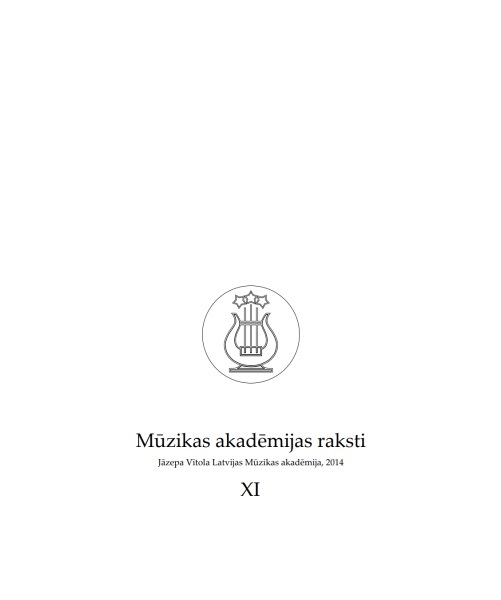THE INTERACTION BETWEEN AURAL ATTENTION COMPONENTS AND MUSIC PARAMETERS BY USING THE COMPUTERIZED TRAINING PROGRAM "AUT"
Keywords:
aural attention training, pitch and rhythm structures, AUT programAbstract
Attention, being a precondition for any cognitive process, has always been of the utmost importance for teachers. Teachers who work with musically gifted children also face problems with insufficient concentration, and an inability to listen attentively.
The research is based on conclusions about aural attention processes, the role of music parameters in the activation of the attention system’s functions, as well as the cognitive processing of acoustic information as a result of structured training. During the research a system of structures was created and it included two music parameters – pitch and rhythm. This system serves as a basis for its computerized model – the training program AUT.
Downloads
References
Altenmüller, Eckart, Maria Schuppert, Helen Kuck, Marc Bangert & Michael Grossbach (2000). Neuronale Grundlagen der Verarbeitung musikalischer Zeitstrukturen. In: Katharina Müller & Gisa Aschersleber (Hrsg). Rhythmus. Ein interdisziplinäres Handbuch. Bern: Huber, S. 59–76
Altenmüller, Eckart, & Gary E. McPherson (2007). Motor learning and instrumental training. In: Wilfried Gruhn & Frances Rauscher (ed.). Neurosciences in Music Pedagogy. New York: Nova Science Publishers, pp. 121–142
Beutel, Manfred E., Peggy Klockenbrink, Jörg Wiltink, Sylvia Dietrich, R. Thiede, Jin Fan & Michael I. Posner (2005). Aufmerksamkeit und exekutive Funktionen bei Patienten mit Adipostas per magna. Der Nervenarzt 77, S. 1323–1331
Biederman, Joseph (2005). Attention-defficit/hyperactivity disorder: A selective overview. Biological Psychiatry 57, pp. 1215–1220
Birbaumer, Niels, & Robert F. Schmidt (1996). Biopsychologie. Berlin: Springer Verlag
Cenova, Valerija = Valeriâ Cenova (red., 2007). Teoriâ sovremennoj kompozicii [Laikmetīgās kompozīcijas teorija]. Moskva: Muzyka
Cusack, Rhodri, John Deeks, Genevieve Aikman & Robert P. Carlyon (2004). Effects of location, frequency region, and time course of selective attention on auditory scene analysis. Journal of Experimental Psychology: Human Perception and Performance 30 (4), pp. 643–656
Fujioka, Takako, Laurel J. Trainor, Bernhard Ross, Ryusuke Kakigi & Christo Pantev (2004). Musical training enhances automatic encoding of melodic contour and interval structure. Journal of Cognitive Neuroscience 16, pp. 1010–1021
Gottselig, Julie Marie, Daniel Brandeis, Gilberte Hofer-Tinguely, Alexander A. Borbély & Peter Achermann (2004). Human central auditory plasticity associated with tone sequence learning. Learning and Memory 11, pp. 162–171
Koelsch, Stefan, Tobias Grossmann, Thomas C. Gunter, Anja Hahne, Erich Schröger & Angela D. Friederici (2003). Children processing music: Electric brain responses reveal musical competence and gender differences. Journal of Cognitive Neuroscience 15 (5), pp. 683– 693
Krumhansl, Carol L. (2000). Rhythm and pitch in music cognition. Psychological Bulletin 126 (1), pp. 159–179
Lappe, Claudia, Laurel J. Trainor, Sybylle C. Herholz & Christo Pantev (2011). Cortical plasticity induced by short-term multimodal musical rhythm training. PloS ONE 6 (6), pp. 1–8
Luck, Steven J., & Shaun P. Vecera (2002). Attention: From paradigms to mechanisms. In: Steven Yantis (ed.). Stevens’ Handbook of Experimental Psychology. Sensation and Perception. New York: Wiley, pp. 235–286
Mathys, Christoph, Psyche Loui, Xin Zheng & Gottfried Schlaug (2010). Non-invasive brain stimulation applied to Heschl‘s gyrus modulates pitch discrimination. Frontiers in Psychology 1, pp. 193
McDermott, Josh H., & Andrew J. Oxenham (2008). Music perception, pitch, and the auditory system. Current Opinion in Neurobiology 18, pp. 1–12
Näätänen, Risto, Petri Paavilainen & Kalevi Reinikainen (1989). Do event-related potentials to infrequent decrements in duration of auditory stimuli demonstrate a memory trace in man? Neuroscience Letters 107, pp. 347–352
Näätänen, Risto, Petri Paavilainen, Teemu Rinne & Kimmo Alho (2007). The mismatch negativity (MMN) in basic research of central auditory processing: A review. Clinical Neurophysiology 118, pp. 2544–2590
Näätänen, Risto, Teija Kujala & Istwán Winkler (2011). Auditory processing that leads to conscious preception: A unique window to central auditory processing opened by the mismatch negativity and related responses. Psychophysiology 48, pp. 4–22
Nagui, Hanna (2009). Attention Deficit Disorder (ADD). Attention Deficit Hyperactive Disorder (ADHD). Is it a product of our modern lifestyles? American Journal of Clinical Medicine 6 (4), pp. 22–31
Neumann, Odman, A.H.C. van der Heijden, & D. Alan Allport (1986). Visual selective attention: Introductory remarks. Psychological Research 48, pp. 1985–1988
Parsons, Lawrence M. (2007). Exploring the functional neuroanatomy of music performance, perception, and comprehension. In: Isabelle Peretz & Robert J. Zatorre (ed.). The Cognitive Neuroscience of Music. New York: Oxford University Press, pp. 211–231
Plahl, Christine, & Hedwig Koch-Temming (Hrsg., 2005). Musiktherapie mit Kindern. Grundlagen – Methoden – Praxisfelder. Bern: Huber
Posner, Michael I. (ed., 2004). Cognitive Neuroscience of Attention. New York: The Guilford Press, pp. 3–12
Posner, Michael I., & Steven E. Petersen (1990). The attention system of the human brain. Annual Review of Neuroscience 13, pp. 25–42
Poulin-Charronnat, Bénédicte, Emmanuel Bigand & Stefan Koelsch (2006). Processing of musical syntax tonic versus subdominant: An event-related potential study. Journal of Cognitive Neuroscience 18 (9), pp. 1545–1554
Raz, Amir, & Jason Buhle (2006). Typologies of attentional networks. Nature Reviews Neuroscience 7 (5), pp. 367–379
Rohling, Martin L., Mark E. Faust, Brenda L. Beverly & George Demakis (2009). Effectiveness of cognitive rehabilitation following acquired brain injury: A meta-analytic re-examination of Cicerone et al.’s (2000, 2005) systematic reviews. Neuropsychology 23, pp. 20–39
Ruggles, Dorea, & Barbara Shinn-Cunningham (2010). Spatial selective auditory attention in the presence of reverberant energy: Individual differences in normal-hearing listeners. Journal of the Association for Research in Otolaryngology 12, pp. 395–405
Stoffer, Thomas H. (2005). Aufmerksamkeitsprozesse beim Musikhören: Wissensunabhängige und wissensabhängige Selektionsprozesse. In: Thomas H. Stoffer & Rolf Oerter (Hrsg.). Allgemeine Musikpsychologie. Göttingen: Hogrefe, S. 591–592
Sussman, Elyse S., Walter Ritter & Herbert G. Vaughan (1998). Attention affects the organization of auditory input associated with the mismatch negativity system. Brain Research 789, pp. 130–138
Valmaggia, Lucia Rita, Theo K. Bouman & Laura Schuurman (2007). Attention training with auditory hallucinations: A case study. Cognitive and Behavioral Practice 14, pp. 127–133
Wacongne, Catherine, Jean-Pierre Changeux & Stanislas Dehaene (2012). A neuronal model of predictive coding accounting for the mismatch negativity. The Journal of Neuroscience 32 (11), pp. 3665–3678
Winkler, Istwán (2007). Interpreting the mismatch negativity. Journal of Psychophysiology 21 (3/4), pp. 147–163
Zatorre, Robert J. (2007). Neural specializations for tonal processing. In: Isabelle Peretz & Robert J. Zatorre (ed.). The Cognitive Neuroscience of Music. New York: Oxford University Press, pp. 231–246
Downloads
Published
Issue
Section
License
Copyright (c) 2024 Mūzikas akadēmijas raksti

This work is licensed under a Creative Commons Attribution 4.0 International License.


